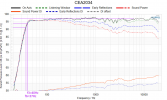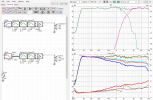Great effort but the value, apart from having fun building it, is not there. A pair of Genelecs 8040 will be cheaper and at least as good.
This looks amazing until I saw the price, now time to go back to genelec and Neumann with my bank account
Yep, the Purifi driver makes the speaker an expensive DIY project.
However, the performance in terms of harmonic distortion (HD), intermodulation distortion (IMD) and displacement volume (DV, i.e. possible achievable sound pressure level in the low bass range) of the Purifi driver are exceptionally good.
With another woofer from SBAcoustics, for example, one could achieve a similar result at a much lower price, with a few sacrifices in HD, IMD and DV.
My hope from this review would be that the purefi woofer would somehow distinguish itself in terms of bass or output but this review doesn't seem to indicate anything special.
When you look at the measurements like this, it's almost boring.
On the other hand, we have a tiny speaker that, according to Amir's measurement, achieves an f3 of around 40Hz (
without DSP expansion) and can also produce reasonably low bass sound pressure levels due to the Xmax of +-10mm.

A cheap 6 or 6.5'' driver has a typical Xmax of about +-5mm. The displacement volume of the Purifi driver therefore corresponds to that of about two inexpensive 6.5'' drivers.
The quality of the drivers used is also reflected in the DSP settings. Very few corrections have to be made to achieve a good result.

Curious about those large distortion spikes at 96dB THD.
As Amir said, the increased harmonic distortion around 400Hz was caused by the measurement setup.
In this frequency range, the Purifi driver and the passive resonator show no abnormalities.
The slightly increased HD3 (see 1. in the graph) around 9kHz and HD2 (see 2.) around 13.5kHz is due to the
violent (damned translation programs

) breakup of the tweeter around 27kHz.
In Amir's measurement the 27kHz break-up is just visible due to the lowpass filter of the measurement system. In reality, this is much more pronounced and the cause of the (inaudible) increased HD values.
Manufacturer measurement of the Seas-DXT tweeter with break-up resonance at 27kHz:
For those interested, I have
attached the complete VCAD project that corresponds to the version of Directiva measured by Amir.

